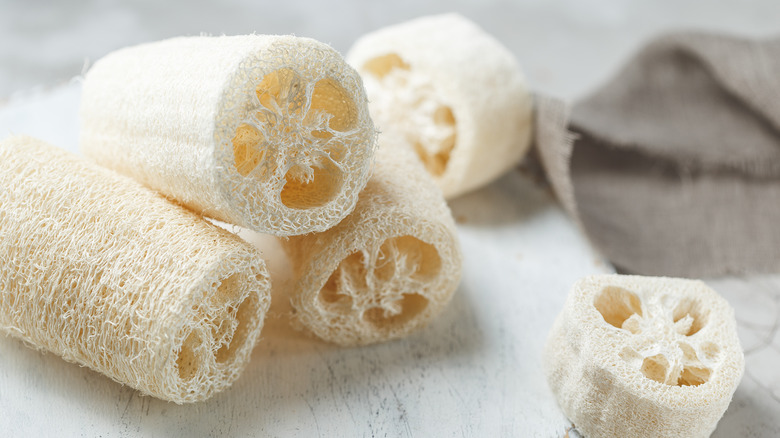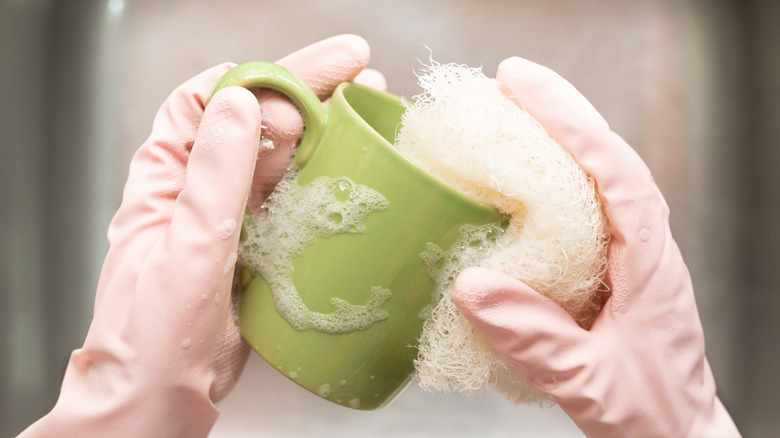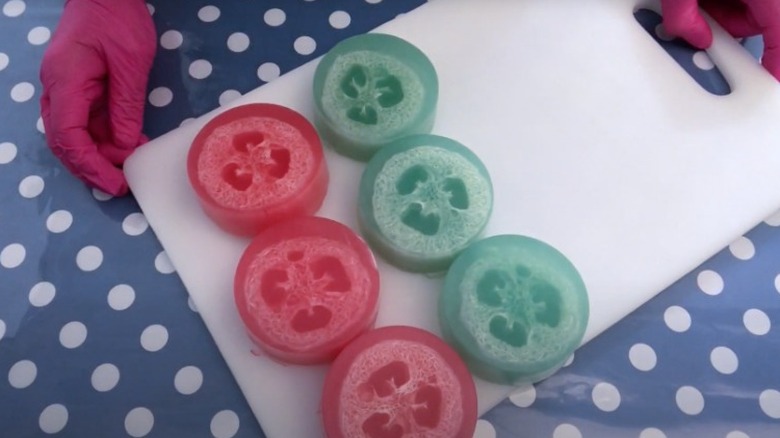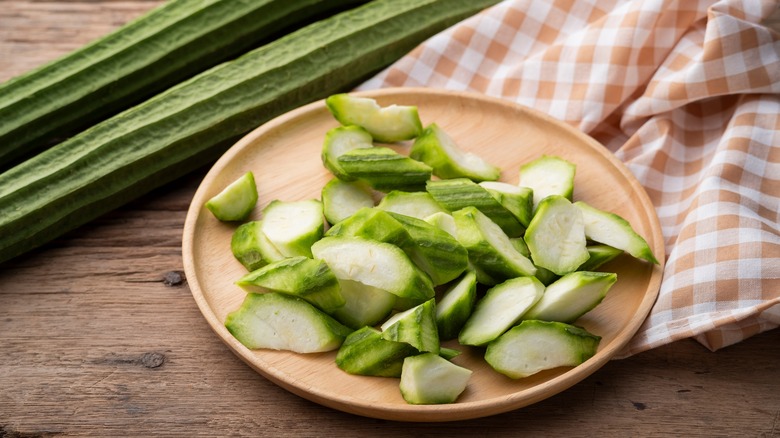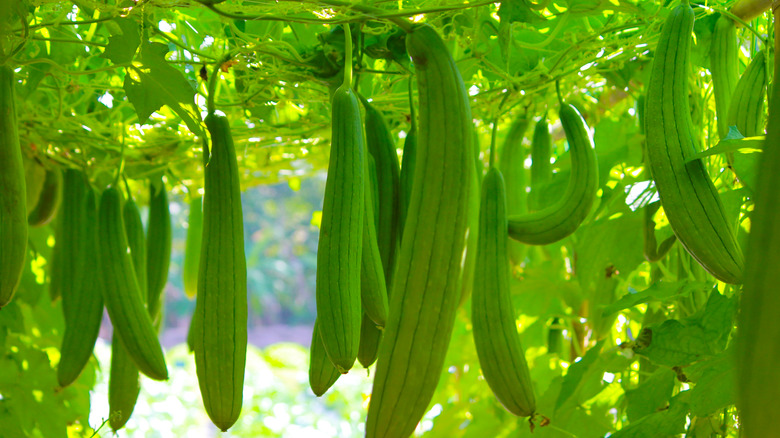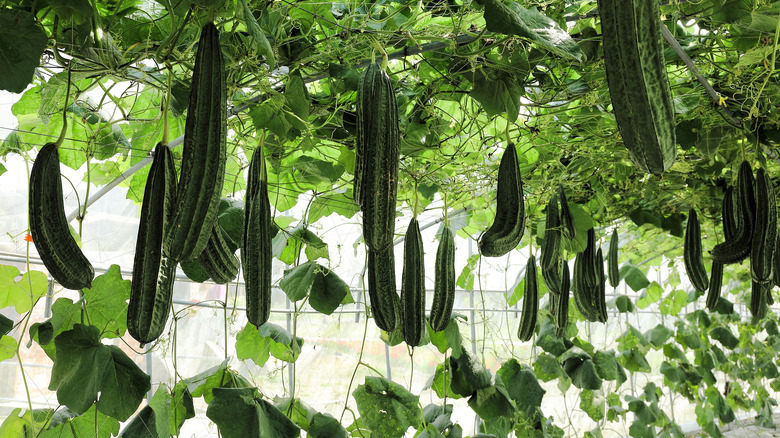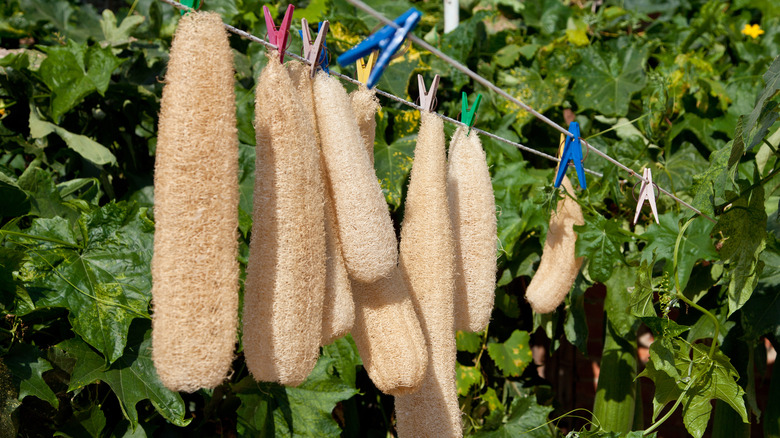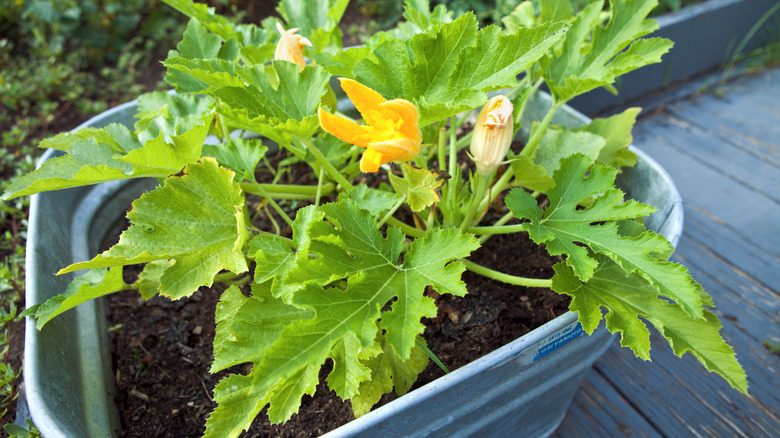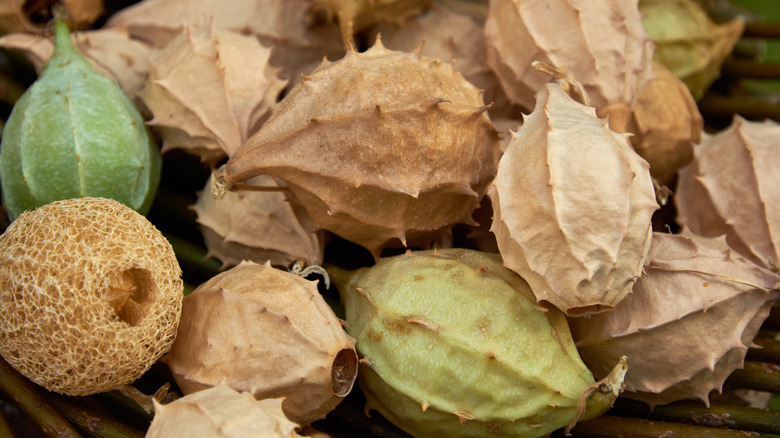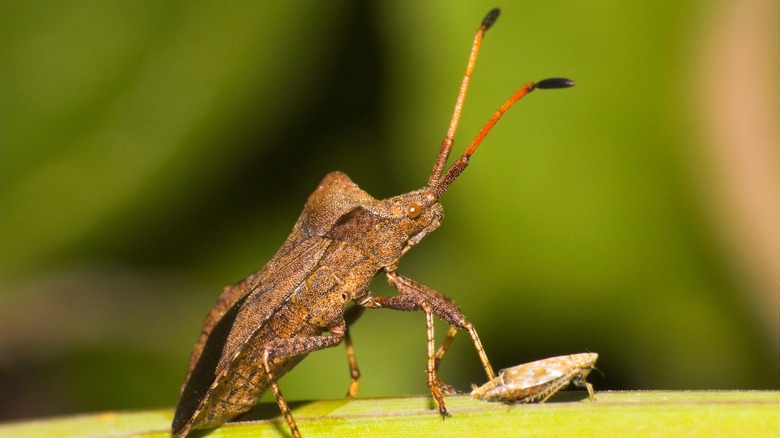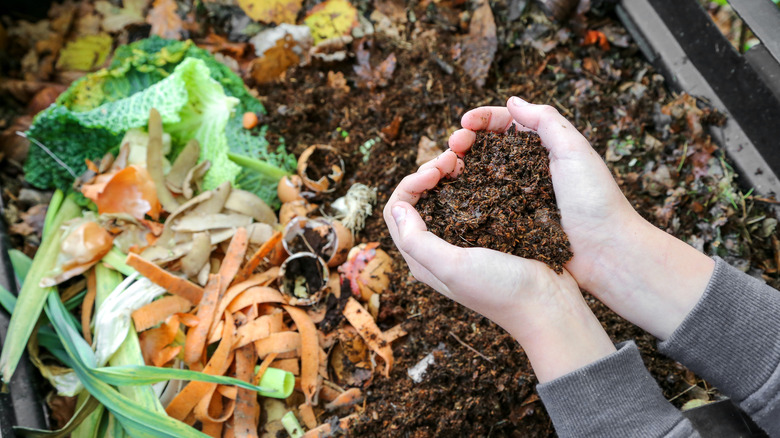Why You Should Be Growing Your Own Luffa (And How To Do It)
It makes perfect sense to think loofah scrubbers come from the ocean; they're associated with water and look quite similar to sea sponges, which are definitely aquatic. But they actually come from a plant that has the same name, just a slightly different spelling: luffa (Luffa cylindrica). The luffa plant is a member of the gourd family, called Cucurbitaceae, and the scrubbers you buy at the specialty soap store are slices (as shown above) of the fiber found inside dried fruit. Before they are dried and peeled, these fruits resemble extra long and skinny cucumbers or zucchinis. You can think of them as cousins within the same vegetable family.
Luffa is what's known as a long-season annual. This means that in order to grow it in a garden you need to live in a region that gets at least 150 days of warm, frost-free weather; USDA grow zones 6 and higher are best. Even though young fresh luffa is edible, the fruits are most often grown to full maturity, dried, and turned into sponges capable of delivering the finest spa treatments, so this plant also goes by the nickname of sponge gourd.
So long as you've got the right environmental conditions, a luffa plant deserves a prime spot in your backyard. If you're already growing cucumbers, pumpkins, zucchini, or summer squash you'd be remiss to not add one more gourd to your garden, especially one with the unique benefit of turning into an all-natural skin exfoliator. For those who are unaccustomed to caring for cucurbits, we've got all the information you need below. So let's take a thorough dive into the wonders of the luffa plant.
How to use a luffa (loofah) sponge at home
The best part of growing your own luffa is that you'll always have a supply of natural, sturdy scrubbing sponges on hand. When used in this way, they're usually called loofahs. Loofahs can be used for exfoliating dry or dead skin, although people with sensitive skin should use caution because the sponges can prove to be irritating and overly abrasive. Loofah sponges can also be used for a slew of household cleaning chores from dishes to counters.
One problem that you might not be aware of is that the fibrous tissue of a loofah tends to hold onto bacteria, especially if it is always kept in a moisture-rich environment like a bathroom. It's important to dry your sponge after each use and keep it sanitized. Hanging it in the shower will encourage bacteria to breed, so take it out and actually dry it with a towel as you dry yourself. Per the Cleveland Clinic, loofahs should be cleaned once a week in a weak solution of water and bleach. They should also be replaced after a month. That's a cost that would add up quickly if you were always heading back to the store to purchase a new one. Yet another reason to add luffa plants to the garden!
Crafting with luffa and other uses
Even if you have no intention of exfoliating yourself or your kitchen counters with a loofah sponge, there are other fun ways to use the plant. Anyone who is into homemade melt-and-pour soaps has seen circular discs of glycerin soap with slices of loofah inside. These are easy to make and give away as creative gifts. You just cut up your dried luffa to an appropriate width and drop it into the mold before covering it in the melted soap.
Crafters have used slices of dried luffa to make stamps that can be dipped in acrylic paint then applied to paper or fabric. And birdwatchers may enjoy stuffing pieces with wild bird food like suet or peanut butter and sunflower seeds. Secure them to tree limbs with twine and enjoy the avian show. The more skilled artisans can try their hand at turning an entire gourd into a birdhouse by peeling the skin of a fully dried gourd and carving out a little doorway in the fibers.
Don't forget, too, that at the end of the day, this is an edible plant just like any other squash. Out of all the members of the gourd family, luffa will taste most similar to zucchini. In the Asian market you might find it labeled as angled luffa, silk squash, or Chinese okra. Larger, older fruits become bitter over time, so for the best flavor stick to young, immature fruit. Dice it, steam it, toss it in a stir fry — any way you eat it, it'll be delightful. And you can roast luffa seeds with a little salt just as you would for pumpkin seeds.
Medicinal properties of luffa plants
Luffa is not only an edible squash but can also be used as medicine. It has been scientifically studied for its therapeutic benefits (via Frontiers in Pharmacology). Luffa is commonly used in traditional Indian medicine (and has been since ancient times) to treat a slew of ailments, from diabetes to ringworm to leprosy. Compounds found in the plant have been shown to have antidiabetic, antimicrobial, anticancer, and antioxidant properties.
For example, a powder made from the fruit is often applied topically to help cure swollen hemorrhoids and insect bites. The seed kernels are eaten to help alleviate dysentery, while the fruit juice is sipped to help with stubborn headaches. The leaves can even be used to help alleviate certain ailments. Specifically, applying muddled leaves is reported to help with ringworm infection and leprosy. You can also save the roots and use them as a laxative, or eat the dried fruit powder to help slow down prematurely graying hair.
How to propagate, grow, and care for luffa
If you're hooked on luffa and can't wait to get started with it in the garden, we've got a ton of tips to help your plants thrive, but first you need to decide if you'll be growing plants from seed or starting with seedlings purchased at the garden center. Luffa seeds are large, flat, and black like the ones you'd find in a watermelon. Keep in mind that the plant is a tropical annual that is native to India and it appreciates a long hot summer; it can take months to properly grow. In order to guarantee that it has enough time to produce mature fruit, most gardeners need to start luffa seeds indoors early in the season. Soak the seeds for an entire day, then sow them ½ inch below the surface of your preferred growing medium. Keep everything warm and moist.
Test the temperature of your soil before transplanting seedlings into the ground; it needs to be at least 70 degrees Fahrenheit. Take note that this is not the temperature of the air, but the actual soil. The spot you choose in your garden needs to receive a minimum of 6 hours per day of direct sunlight, and more is even better. Well-draining soil with a pH that leans towards alkaline in the 6.0 to 6.5 range is best. Compost will help increase the nutrient density of the soil. Finally, mulch will insulate the ground so the soil stays warm and consistently moist.
Supporting luffa gourds with a trellis
Just like their other squash family relatives, luffas are vining plants that will spread out as far as they possibly can if you let them; a healthy luffa can stretch up to 50 feet in all directions. These large plants often benefit from physical support structures. Cages, trellises, or fencing give the sprawling climbers a way to get themselves off of the ground and away from the hungry mouths of small wildlife. Vertical growing also keeps them healthier by encouraging air flow and cutting down on persistent diseases.
Whichever vertical option you choose, you'll need to train the tendrils of the vines to latch onto the support structures. You can do this by wrapping them around wires or poles, or tying them to posts every few feet as they grow. Zip ties come in handy for this; just make sure to secure them loosely so the vines don't get damaged. Start this process when the plants are young and you'll end up with quite a bit of control over where and how they spread.
Trellised luffa may require more water than plants that lay on the ground because the vines that have reached great heights will be dealing with excessive moisture evaporation. Both the sun and the wind increase this likelihood, and it's also possible that the plants will focus more energy on growing up than they will in securing roots downwards. Boost your irrigation schedule, particularly when plants begin to show signs of fruiting.
How to harvest and dry luffa
Deciding when to harvest luffa fruit depends on whether you want to eat it or soak with it in the bathtub. You'll be looking at 60 to 90 days before you can pick luffa to eat and upwards of 200 days if you prefer to use the dried interior fiber for an exfoliating sponge. So settle in with a good book because, either way, this will take a minute.
For cooking, pick the fruit when it is green and under 7 inches long. This ensures it will still taste good and not bitter. For scrubbers, leave the fruit on the vine until it turns brown and crispy. If they fall from the tree early, you can lay them out in the sun to dry. Do not bring them indoors at any point during this time; drying luffa gourds indoors is not encouraged as it can lead to rotting and black slimy messes.
In the event that you have no choice but to start with a still-green fruit rather than a dry one, buckle up for a sloppy affair. Use gloves to peel the skin and remove any pulp, juice, or sap on the inside. Then soak the fibrous core in water overnight to loosen up any remaining bits. To blast out any remaining seeds, a strong spray from the hose should help. After the core is clean, wring out any residual water and allow your new loofah sponge to completely dry, either by hanging it in full sun or placing it in the oven at a very low temperature.
Growing luffa in containers and repotting
Yes, as mentioned, vining gourds love to have an expansive amount of space to spread themselves out, but they can still be successfully grown in smaller areas like balconies and porches. When properly tended, luffas will thrive in containers just as they would in a trellised patch of garden. For best results, containers should be at least 5 gallons in size and you can actually use a standard 5-gallon bucket so long as you drill drainage holes into the bottom of it.
Remember that the tendrils are going to sprawl and attach themselves to whatever they find for support. In a container garden this means two things: First, you'll still need a support system like a wooden ladder or trellis just as you would in the garden. Second, you won't be able to move your container once the plant is flourishing. This is important to think about because sometimes the best thing about a container garden is you can rotate the pots for better sun exposure or protection. Not only is a 5-gallon bucket full of soil going to be very heavy, but luffa plants don't usually survive being transplanted. Wherever you start your container-grown luffa is where it's going to stay.
Varieties of luffa
Within the scientific classifications of botany, common luffa has two names that are considered synonyms, meaning they are interchangeable. These names are Luffa cylindrica and Luffa aegyptiaca. If you see either of these names on a seed packet or starter seedling, know that you're getting the common smooth luffa sponge gourd. There are two other varieties to consider; when you're deciding which is best to plant, you won't be thinking about bloom colors or distinct flavor profiles like you would with most of your other flowers or vegetables. Instead, you'll focus on whether or not you intend to eat it or what shape sponge you want.
Ball luffa (Luffa operculata), pictured above, is similar to smooth luffa in that it makes a great fibrous sponge, but it has a very different shape and is much smaller. Ball luffa also gets used as a homeopathic remedy for constipation, tumor growth, and water retention.
Angled luffa (Luffa acutangula) is the most common cultivar used for cooking Asian cuisine. Physically it resembles a zucchini with its long and skinny tapered shape, and it has a slightly bitter taste that gets worse as the fruit matures. For the best tasting meal, always opt for the youngest fruits.
Common pests and diseases with luffa plants
Oh, squash bugs, must you invade our happy little plants and make it so hard to love you? We know you're just trying to survive like the rest of us, but do you have to cause wilt and scarring as you go? Unfortunately, yes, they do. Squash bugs (Anasa tristis) are pesky little pests that sure do fancy all things cucurbit. They lay their tan or red colored eggs on the leaves. Once hatched, the nymphs move to the base of the plant where they proceed to suck out the sap with their piercing mouthparts. The affair involves a toxin that blackens leaves and can eventually kill the entire plant. To stop a population of squash bugs from ruining your crop, regularly check the undersides of the leaves for eggs and pick off any nymphs or adult bugs. Try using insecticidal soaps and store-bought pyrethrin sprays, but concentrate most of your efforts on maintaining the cleanest environment possible by removing dead or decaying leaves and installing row covers.
Common diseases for the luffa plant include the standards most gardeners are used to: downy and powdery mildew, anthracnose, and root rot. Though unrelated, all are best treated by employing preventative practices right from the start. Use drip irrigation to ensure that foliage stays dry. Remove decaying leaves and prune when necessary to create adequate air circulation. Don't plant seedlings too close together and rotate all squash plants to a different area in the garden each season. For extensive outbreaks, consult your local nursery about copper sprays, sulfur powders, or neem oil applications that may be beneficial before resorting to harsh fungicides.
Best fertilizer practices for luffa
Luffa loves nutrient-rich soil and there's a lot you can do before reaching for a bag of chemical fertilizer. For this task, think soil conditioners like compost, manure, mulch, and peat moss. Then look around your yard for any naturally occurring organic matter that can be transferred into your garden soil. Naturally decomposing organic matter is going to include grass clippings after you mow, mosses and lichens, raked-up leaves, and decaying fruits from vegetable plants that you didn't get to harvest in time to eat. All of these ingredients will work hard to create healthy soil and a strong root system for your plant.
None of this is meant to suggest that you shouldn't feed your luffa plants with appropriate fertilizer; they are just ways to make use of everything at your disposal. When it comes time to apply a chemical fertilizer look for an all-purpose plant food with a composition that is balanced across the three most prominent ingredients: nitrogen, phosphorous, and potassium (shown as NPK on the fertilizer label). Slow-release fertilizers are popular because they do not stress out or burn plants, and you can trust them to feed your plants appropriately over an extended period of time.
